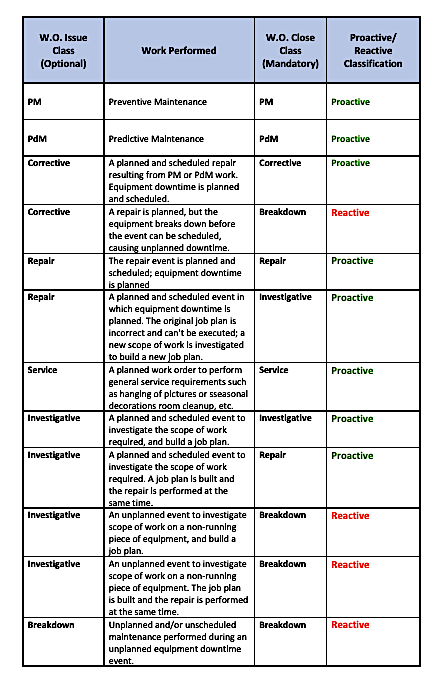Einstein once said there are three rules of work: “Out of clutter find simplicity. From discord find harmony. In the middle of difficulty lies opportunity.” Those rules seem quite applicable in today’s RAM arena.
Work is an honorable pursuit that does not include working for work’s sake. Work should be efficient, effective, and above all meaningful. In my 30+ plus years of performing Maintenance Operation Effectiveness Reviews (MOERs), and examining and studying maintenance performance across all disciplines and industry types, I’ve found that between 30% and 70% of such work is unnecessary. This is due, in part, to legacy PMs that are no longer relevant, are not objectively written, are ineffectively scheduled, or simply not completed, thereby causing premature asset failures that require additional corrective, reparation, and restoration work. In many cases, this becomes a repetitive cycle stemming from a lack of work tracking, classification, reporting and, very important, an understanding of good versus poor work practice and management.
THE WORD ‘UNDERSTANDING’ IS KEY
To understand work practices and recognize opportunities for change, maintenance must understand the ineffectiveness of its current planning-and-scheduling work methods through analysis of historical work data. Unfortunately, many work-management systems aren’t set up to allow ready accessing and mining of collected data and, in turn, to reflect that data through timely, meaningful performance reports.
What differentiates a work management system, commonly referred to as a Computerized Maintenance Management System (CMMS), or Enterprise Asset Management (EAM) system from a simple work order system, is its ability to access, collate, sort and filter data in accordance with the end user’s defined needs. Simply put, it allows an end user to convert historical data into meaningful reporting information for decision-making purposes. All asset management systems offer the ability to set up “Code” tables that interact with the work order allowing the user to definitively collate and filter work order data that pertains to pre specified code labels.
SETTTING UP YOUR SYSTEM TO BETTER UNDERSTAND WORK
One of the most effective ways of understanding work is to code the type of performed. This is achieved using the code tables named Type/Sub-Type, Category/Sub-Category, or Classification/Sub-classification. If no coding tables are readily available, the system’s software provider is often able to offer these tables as a customization.
The primary sort table helps us understand the type of issues faced on a daily basis useful for facilitating work request flow, Planner work loading and trade group work loading and staffing levels.
Typical primary work-type sort codes may include:
-
- Electrical (Machine/Building/Vehicle)
- Electronic (Machine/Building/Vehicle)
- Mechanical (Machine/Vehicle)
- Structural (Building)
- Plumbing (Machine/Building)
- HVAC (Building/Vehicle)
- Carpentry (Building).
The secondary work-type code is used to code the work order itself. The work-order type groups the type of work performed and allows maintenance to determine the relationship and effectiveness of proactive versus reactive work, and planned versus unplanned work. Performing work in a reactive environment is 2 to 5 time more costly than performing work in a Proactive environment. The proactive work environment fosters strategies and management practices that result in more effective resource management, and reduced work backlogs.
Proactive Work. Preventive, Predictive, Condition Based, and Planned Run To Fail are all proactive work strategies. Through assessment and trending for pending failure, corrective action can be planned, scheduled and executed well in advance of any eventual breakdown occurrence; proactive work maximizes equipment uptime.
Reactive Work. In comparison, reactive work is an unplanned, unscheduled, and often unnecessary response to equipment breakdown. In an effort to minimize loss of service caused by equipment downtime, reactive repairs are often “quick-fix,” or temporary solutions that again can result in unnecessary repetitive, premature failures.
Typical work-order-type sort codes may include:
Emergency WO Type. In the event of a true emergency (911) event, work is often scheduled without a work order. Once the work is complete and the emergency addressed, the work and any parts used can be captured and easily retrieved for reporting purposes when captured on a “Emergency Work Order” type. The Emergency Work Order should be the least-used type of work order.
PM – Preventive WO Type. A :PM Work order can be issued against any physical asset that has consequence to its failure, specifically:
-
- Its failure will cause a safety issue.
- Its failure will cause a loss of service.
- Its failure will cause an environmental loss.
- Its failure will result in high replacement or repair costs.
A PM Work order can be issued for any calibrated device (instrument, tool, scale), safety device (harness, gas analyzer, retractable lanyard, hoist) or regulated entity (pressure relief valve, crane, forklift) requiring routine calibration, certification and/or evidence of regulatory compliance. A PM Work order defines a routine recurring event that is planned and scheduled according to:
-
- Calendar (daily, weekly, monthly, annually, etc.)
- Meter Readings (Hours, Kilometers, Gallons / Liters, etc.)
- Condition Readings (Level, amperage, flow-rate, vibration, temp,Go/No-Go state).
A typical PM job plan may include cleaning, lubrication, filter change, inspection, minor adjustments, calibrations, and equipment certifications.
PdM – Predictive WO Type. A “PdM Work Order” can be issued against any physical asset and is used to augment the PM program. PdM Work is non-intrusive work that allows the maintainer to inspect assets using a variety of diagnostic tools that can tangibly capture trending data used to establish an equipment signature baseline and track baseline deviations to determine if the asset’s condition is deteriorating, and at what rate. This information is then used to predict failure so that a suitable proactive maintenance reparation approach can be exercised in advance of a failure occurrence.
A PdM Work Order can define a single event or routine recurring event that is planned and scheduled according to:
-
- Calendar (daily, weekly, monthly, annually, etc.)
- Meter Readings (Hours, Kilometers, Gallons / Liters, etc.)
- Condition Readings (Level, Cleanliness, etc.).
The majority of PdM work includes diagnostic checks, verifications and a typical PdM job plan may employ use of the following diagnostic methods:
-
- Air balancing
- Amperage testing
- Infrared Thermography
- Flow metering
- Laser alignment
- Oil analysis
- Ultrasonic (acoustic) testing
- Vibration Analysis
- Corona discharge testing..
Investigative WO Type. An “Investigative Work Order” is created when the work-request job scope is unclear and needs further clarification/information to plan or complete the job. Investigative Work Orders are issued specifically to troubleshoot equipment when the problem is unknown. The investigative Work Order is also used to develop a scope of work for planning and scheduling purposes when the planner is not available to personally view the equipment problem.
Corrective WO Type. A “Corrective Work Order” is created as a direct result of work found and recommended on completed PM and PdM Work Orders. Corrective Work Orders are fully job planned and include labor and material requirements. This type of work order is used to analyze PM effectiveness, assess PM-frequency-adjustment requirements, and develop evolution of PM scope.
Repair WO Type. A “Repair Work Order” is created to cover planned equipment repair/redesign/upgrade events in which equipment downtime is scheduled. Repair Work Orders are issued specifically to cover:
-
- Work resulting from impaired or reduced equipment performance and/or design specification
- Work resulting from Investigative Work order recommendations
Service WO Type. A “Service Work Order” reflects planned work to perform basic services for the client. Such work can include picture hanging, furniture moving, room cleanup, and installation and removal of seasonal decorations, etc.
Breakdown WO Type. A “Breakdown Work Order” is a truly reactive-work order. It’s used when an asset has failed and is no longer functioning. The Breakdown Work Order is the second-least desirable work-order type after the Emergency Work Order type.
Shutdown WO Type. A “Shutdown Work Order” is issued for planned work on assets that are taken out of commission for a short periods so that multiple repairs can be performed at the same time repairs. Shutdown work is planned and scheduled well in advance of the event.
Training WO Type. A “Training Work Order” is a planned-work order used to track time spent on training activities by a maintainer. This is useful when the trade timesheet is linked directly to work order time charges.
Contractor Assistance WO Type. A “Contractor Assistance Work Order” is a planned-work order used to track internal resource time allocated to assist or supervise (oversee) contractors so that a true contractor-cost can be calculated.
Note that most software will allow you to change the WO type prior to closing. If this option is exercised (highly recommended) reporting should be on the more accurate closing WO type. Table I (below) shows how work data can be collated to calculate and understand the ratio of proactive to reactive work.
 Table I. Understanding Proactive versus Reactive Work Using WO Type Codes
Table I. Understanding Proactive versus Reactive Work Using WO Type Codes
Finally, if the trade designation and maintainer name or badge number is also field-assigned on the work order, these details can be used as additional data filters to develop powerful work-associated reports filters to understand the work performed, the impact of that work, and how work is distributed and managed across the maintenance organization—all from a few simple, easy-to-use codes.TRR
ABOUT THE AUTHOR
Ken Bannister has 40+ years of experience in the RAM industry. For the past 30, he’s been a Managing Partner and Principal Asset Management Consultant with Engtech industries Inc., where he has specialized in helping clients implement best-practice asset-management programs worldwide. A founding member and past director of the Plant Engineering and Maintenance Association of Canada, he is the author of several books, including three on lubrication, one on predictive maintenance, and one on energy reduction strategies, and is currently writing one on planning and scheduling. Contact him directly at 519-469-9173 or kbannister@theramreview.com.
Tags: work management, code management, sort codes, maintenance reporting. asset management reporting, work order types, CMMS, EAM, maintenance management



